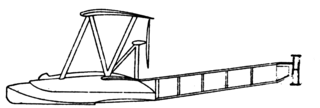Related Research Articles

The Vickers F.B.5 was a British two-seat pusher military biplane of the First World War. Armed with a single .303 in (7.7 mm) Lewis gun operated by the observer in the front of the nacelle, it was the first aircraft purpose-built for air-to-air combat to see service, making it the world's first operational fighter aircraft.
The Grahame-White Type X Charabanc or Aerobus was a 1910s British passenger-carrying biplane designed and built by the Grahame-White Aviation Company based at Hendon Aerodrome, North London.

The Hansa-Brandenburg CC was a single-seat German fighter flying boat of World War I. It was used by both the Kaiserliche Marine and the Austro-Hungarian Navy.
The Grahame-White Type XI was an early aircraft built in the United Kingdom and marketed as being particularly well-suited to military applications. It was a two-bay biplane of pod-and-boom configuration with unstaggered wings of slightly unequal span. The pilot and an observer sat in tandem, open cockpits in a streamlined nacelle, with the engine mounted pusher-fashion behind them. Unusually for an aircraft of this period, the propeller was not driven directly by the engine, but rather, via a sprocket and chain system that geared it down in the ratio of 14/23. The undercarriage was of the fixed, tailskid type but was designed to be easily exchanged for pontoons. Construction throughout was fabric-covered wood, with the exception of a neat aluminium cowling for the engine and transmission. A sample was exhibited at the Olympia Aero Show in 1914.

The Bréguet Type I was an experimental aircraft built in France in 1909. It was Louis Bréguet's first fixed-wing aircraft design. Bréguet had previously had some success with two helicopter designs, one of which had been exhibited at the Paris Aero Salon in December 1908. Because of these machines, the Type I was at first known as the Bréguet Type III.

The Blackburn Triplane was a single-engine pusher single-seater, designed specifically to attack Zeppelins. It flew in 1917, but was not successful.

The White and Thompson No. 3 was a British flying boat of the First World War. While the prototype was originally designed to compete in an air-race around the UK, eight more similar aircraft were built for the Royal Naval Air Service.
The Grahame-White Ganymede was a prototype British heavy night bomber intended to serve with the Royal Air Force in the First World War. A large, three-engined, twin-boom biplane, the sole prototype Ganymede did not fly until after the war had ended, and although an attempt was made to convert the aircraft to an airliner, it was unsuccessful.

The Vickers Type 161 was an unusual 1930s pusher biplane interceptor, designed to attack aircraft from below with a single upward-angle large calibre gun. The aircraft flew well but the concept was abandoned and only one was built.
The Short No.2 was an early British aircraft built by Short Brothers for J.T.C. Moore-Brabazon. It was used by him to win the £1,000 prize offered by the Daily Mail newspaper for the first closed-circuit flight of over a mile (1.6 km) to be made in a British aircraft.

The Zeppelin-Lindau Rs.II was a biplane flying boat, designed by Claudius Dornier and built during 1914-15 on the German side of Lake Constance. Initially this aircraft was powered by three engines mounted inside the hull driving three pusher propellers via gearboxes and shafts. The later version was powered by four engines in two push-pull nacelles mounted between the wings.
The Vickers E.F.B.1 'Destroyer' was an early British military aircraft prototype. Although not itself a success, the design was considered worth developing, and a series of similar aircraft were produced in prototype form, eventually leading to the Vickers F.B.5 "Gunbus", which saw widespread service during World War I.
The Graham-White Type VII "Popular" was an early British aircraft designed by J. D. North and built by the Grahame-White Aviation company, with the intention of producing a low-cost aircraft to popularize aviation. It was initially produced with a 35 hp Anzani 3-cylinder Y configuration engine and offered for sale at a price of less than £400. Despite its low price the aircraft included structural refinements such as hollow-section interplane struts. It was first flown in 1913.

The Hanriot H.110 was an unusual pusher configuration, twin boom, single seat fighter aircraft built in France in the early 1930s. It proved to be slower and less manoeuvrable than its contemporaries and failed to reach production, even as the Hanriot H.115 after receiving a more powerful engine and cannon armament.

The Siemens-Schuckert L.I was a large, three-engined biplane bomber aircraft, built in Germany towards the end of World War I. It was a twin boom design, strongly influenced by the successful Caproni Ca.3. Three were built but not used operationally.
The Royal Aircraft Factory F.E.6 was a two-bay, single-engine pusher biplane built by the British Royal Aircraft Factory, a larger version of their F.E.3.

The Voisin Type de Course was an early French aircraft built by Voisin Frères. It was first flown early in 1910.

The Lloyd 40.08 Luftkreuzer was a three engine triplane bomber type built during World War I. The design was proven to be ineffective and development did not proceed past the prototype stage.
The Oeffag G , sometimes known as the Oeffag Type G or Oeffag-Mickl G, was a three-engined reconnaissance flying boat built in Austria during the First World War and deployed by the Kaiserlich und Königlich Seefliegerkorps.
The Aviatik 30.24 was a prototype Austro-Hungarian triplane fighter built by Aviatik in World War I.
References
- Brew, Alec. The Turret Fighter. Ramsbury, Malborough, UK: The Crowood Press, 2002. ISBN 1-86126-497-6.
- Mason, Francis K. The British Fighter Since 1912. London: Putnam, 1992. ISBN 0-85177-852-6